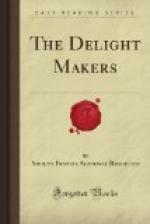“Opona,—’come in,’” responded a woman’s voice. Both lads obeyed the summons. At first the room seemed dark on account of the sudden contrast with the glare outside, but as soon as this first impression was overcome, it appeared moderately lighted. It was a chamber about fourteen feet long and ten feet wide, and its walls were whitewashed with burnt gypsum. Deer-hides and a mat plaited of yucca-leaves lay rolled up in one corner. A niche contained a small earthen bowl, painted white with black symbolic figures. A doorway to the right led into another compartment which seemed darker than the first. As soon as the boys entered the room, a woman appeared in this side doorway. She was small, slender, and apparently thirty-five years of age. Her features, notwithstanding the high cheek-bones, were attractive though wan and thin. An air of physical suffering lay over them like a thin cloudy veil. At the sight of this woman, Okoya’s heart began to throb again; for she it was whom he so direly suspected, nay, accused of treachery and deceit. This woman was his mother.
FOOTNOTES:
[Footnote 1: The word “umo” properly signifies “grandfather;” but it is used indiscriminately for all ages and sexes in calling. An old man, for instance, will call his grandchild “umo;” so will a wife her husband, a brother his sister, etc.]
[Footnote 2: Estufa properly means a stove, and the name was applied to those semi-subterranean places by the Spaniards on account of their comfortable temperature in winter. They recalled to them the temaz-calli, or sweat-houses, of Mexico.]
[Footnote 3: The preservation of traditions is much systematized among the Pueblo Indians. Certain societies know hardly any other but the folk-tales relating to their own particular origin. To obtain correct tradition it is necessary to gain the confidence of men high in degree. That is mostly very difficult.]
CHAPTER II.
The homes of the Pueblo Indians of New Mexico, especially as regards the size and disposition of the rooms, are to-day slightly modified from what they were in former times. An advance has been made, inasmuch as the buildings are not any longer the vast and ill-ventilated honeycombs composed of hundreds of dingy shells, which they were centuries ago. The houses, while large and many-storied, are comparatively less extensive, and the apartments less roomy than at the time when the Queres lived in the Rito de los Frijoles.
The two rooms where we left the lads and their mother at the close of the preceding chapter formed such a home. In the front one the family slept at night, with the exception of Okoya who was obliged to join the other youths in the estufa of his clan. The husband was not always at home after sunset. But the mother, Shyuote, and a little girl four years old invariably took their nightly rest there. To the little girl we have not yet been introduced. When the boys returned she was in the court-yard at play, and in the usual state of complete undress which is the regular condition of Indian children of her age.




